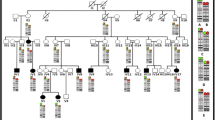Summary
Mental retardation is defined by significant limitations in intellectual function and adaptive behavior that occur before 18 years of age. Many chromosomal diseases come with mental retardation. We reported two Chinese families with partial trisomy 9p and other chromosome partial monosomy, clinical features of mental retardation and mild facial and pinkie anomalies. In the family 1, we showed that the proband carried a trisomy 9p21.3→pter and monosomy 21q22.3→qter by using fluorescence in situ hybridization analysis. Molecular genetic analysis defined the precise breakpoint on chromosome 9p between markers D9S1846 and D9S171, an interval of about 2.9 Mb on 9p21.3, and the breakpoint on chromosome 21q between markers D21S1897 and D21S1446, a region of about 1.5 Mb on 21q22.3. In the family 2, a patient with trisomy 9p21.3→pter and monosomy 5p15.33→pter, and a de novo maternal balanced translocation between chromosomes 5 and 9 was identified in his mother. Cytogenetic and molecular genetic analysis defined the precise breakpoints on chromosome 9p21.3 and chromosome 5p15.33. Further clinical investigation found that any individual had no refractoriness eczema disease except the proband in this family. These results further implicate that trisomy 9p is associated with mental retardation, and that there may be key gene duplication on chromosome 9p21.3→9pter responsible for mental retardation and mild facial anomaly. This result has been applied successfully in prenatal diagnosis of the second family.
Similar content being viewed by others
References
Rethore MO, Larget-Piet L, Abonyi D, et al. 4 cases of trisomy for the short arm of chromosome 9. Individualization of a new morbid entity. Ann Genet, 1970,13(4): 217–232
Sutherland GR, Carter RF, Morris LL. Partial and complete trisomy 9: delineation of a trisomy 9 syndrome. Hum Genet, 1976,32(2):133–140
Young RS, Reed T, Hodes ME, et al. The dermatoglyphic and clinical features of the 9p trisomy and partial 9p monosomy syndromes. Hum Genet, 1982,62(1):31–39
Wilson GN, Raj A, Baker D. The phenotypic and cytogenetic spectrum of partial trisomy 9. Am J Med Genet, 1985,20(2):277–282
Smart RD, Viljoen DL, Fraser B. Partial trisomy 9-further delineation of the phenotype. Am J Med Genet, 1988,31(4):947–951
Littooij AS, Hochstenbach R, Sinke RJ, et al. Two cases with partial trisomy 9p: molecular cytogenetic characterization and clinical follow-up. Am J Med Genet, 2002,109(2):125–132
Angle B, Yen F, Cole CW. Case of partial trisomy 9p and partial trisomy 14q resulting from a maternal translocation: overlapping manifestations of characteristic phenotypes. Am J Med Genet, 1999,84(2):132–136
Chen CP, Tzen CY, Chang TY, et al. Prenatal diagnosis of partial trisomy 3p and partial monosomy 11q in a fetus with a Dandy-Walker variant and trigonocephaly. Prenat Diagn, 2002,22(12):1112–1113
Piram A, Ortolan D, Peres LC, et al. Newborn with malformations and a combined duplication of 9pter-q22 and 16q22-qter resulting from unbalanced segregation of a complex maternal translocation. Am J Med Genet A, 2003,120A(2):247–252
Lewandowski RC Jr, Yunis JJ, Lehrke R, et al. Trisomy for the distal half of the short arm of chromosome 9. A variant of the trisomy 9p syndrome. Am J Dis Child, 1976,130(6):663–667
Schnater JM, Schouten-van Meeteren AY, Heins YM, et al. Hepatoblastoma in a patient with a partial trisomy 9p syndrome: a case report. Cancer Genet Cytogenet, 2005,156(1):77–79
Gigli GL, Scalise A, Silvestri G, et al. Clinical case report: multiple idiosyncratic adverse effects of antiepileptic drugs in trisomy 9p. Int J Neurosci, 1996,87(3–4):181–189
Stern JM. The epilepsy of trisomy 9p. Neurology, 1996,47(3):821–824
Zhuang H, Kosboth M, Lee P, et al. Lupus-like disease and high interferon levels corresponding to trisomy of the type I interferon cluster on chromosome 9p. Arthritis Rheum, 2006,54(5):1573–1579
Ricart J, Pareja IE. Trisomy 9p associated with self-injured behavior and multiple intractable keloids. J Eur Acad Dermatol Venereol, 2006,20(8):1020–1021
Wang X, Li S, Liu H, et al. Automated identification of analyzable metaphase chromosomes depicted on microscopic digital images. J Biomed Inform, 2008,41:264–271
Bossolasco P, Montemurro T, Cova L, et al. Molecular and phenotypic characterization of human amniotic fluid cells and their differentiation potential. Cell Res, 2006,16(4):329–336
Wang XR, Luo RL, Dai XH, et al. Cytogenetic analysis of partial trisomy 9p resulting from a reciprocal balanced 9/21 translocation. Yi Chuan (Chinese), 2007,29(7):813–816
de Ravel TJ, Fryns JP, Van Driessche J, et al. Complex chromosome re-arrangement 45,X,t(Y;9) in a girl with sex reversal and mental retardation. Am J Med Genet A 2004,124A(3): 259–262
Author information
Authors and Affiliations
Corresponding author
Additional information
Both authors contributed equally to this work.
This project was supported by grants from National Natural Sciences Foundation of China [No. 30670736 and No. 30972655 (J.Y.L.)].
Rights and permissions
About this article
Cite this article
Feng, A., Dai, X., Wang, X. et al. Molecular genetic analysis of partial 9p trisomy in two Chinese families with mental retardation and facial anomaly. J. Huazhong Univ. Sci. Technol. [Med. Sci.] 31, 570–577 (2011). https://doi.org/10.1007/s11596-011-0492-2
Received:
Published:
Issue Date:
DOI: https://doi.org/10.1007/s11596-011-0492-2




